Violent Purple-Red Thigh Rash in an Aged Woman
This pruritic rash appears to be a drug reaction to a cephalosporin. This class of drug often produces allergic reactions in the skin; this was quite an ordinary one, neither vasculitic nor urticarial. The mucosa was not affected, which ruled out Stevens-Johnson syndrome.
HISTORY
An 83-year-old woman is seen in outpatient clinic because of a tremendously pruritic rash of 7 days’ duration. Has not changed laundry detergent or soap, nor worn new clothing without washing it. Lotion and colloidal oatmeal baths have not helped. Has mild dementia but is well able to describe current and recent symptoms.
Two weeks earlier had bronchitis. Took oral cephalosporin that was prescribed, but only for 4 days; cough and fever abated promptly, but skin began to itch. Stopped antibiotic on her own without calling in. Then rash appeared and quickly spread. Did not have antibiotic-induced diarrhea.
Has taken phenytoin and phenobarbital for a seizure disorder without incident, for many years. Serum levels are in the therapeutic range.
PHYSICAL EXAMINATION
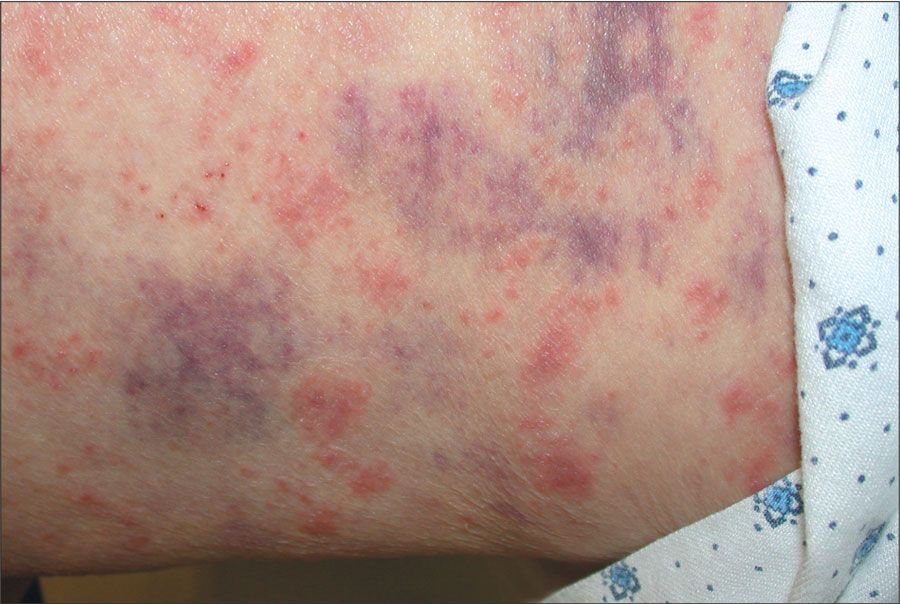
Uncomfortable woman who scratches her arms and shoulders frequently, then apologizes for lack of self control. Temperature, pulse, and respiration rate normal; SaO2, 94% on ambient air. Chest clear. Abdomen not distended. Mouth, nails, and eyes normal. Extensive purple ecchymoses and red raised areas on skin of legs; smaller but similar areas on arms, some with marks of excoriation. No vesicles. Breasts are spared. No herald patch or target or iris lesion is seen.
LABORATORY RESULTS
Eosinophils, 14.3% of differential white blood cell count.
What's Your Diagnosis?
ANSWER: SEVERE DRUG RASH PRESUMPTIVELY FROM CEPHALOSPORIN
At least half of the skin of the thigh seen here is covered by lesions. The purple ones appear to be simple ecchymoses, without any break in the skin; they could still be traumatic, since subepithelial microvasculature is often rent by non-penetrating injury. The bruises are numerous, and despite the caveats about inferring the age of bruises,1 they appear fresh.
Red-pink lesions in between are mostly nondescript. Some hint at elevation and could make one wonder about urticaria, but most are flatter and none have the pink uniformity that is so characteristic of (most) hives. Small papules predominate; a subset have coalesced into larger lesions. Some, especially toward the lower right, suggest slight scaling; this, together with the unroofing of a few toward the upper left, implies further damage from excoriation. Nowhere are there the minute red-purple dots of fresh purpura (petechiae).
Based on the history and the lack of other causes, we diagnosed a drug reaction. The time course and the lack of other changes implicated the cephalosporin. This class of drug often produces allergic reactions in the skin; this was quite an ordinary one, neither vasculitic nor urticarial; bizarre variants can also occur.2
CLINICAL DIAGNOSIS OF RASHES: SOME POINTERS
Recognition of a drug rash can prove very easy, or brutally difficult. One relies on recognizing pattern, and especially, one takes the history with special attention to infections and contact irritants, as well as to highly allergenic (and skin-affecting) drugs.3 Physical examination encompasses the entire skin (Figures 1 through 7), mucosa (Figures 8 and 9), and skin appendages and derivatives (Figure 10). Only with this full picture can one spy a pattern and feel confident that elements have not been overlooked.
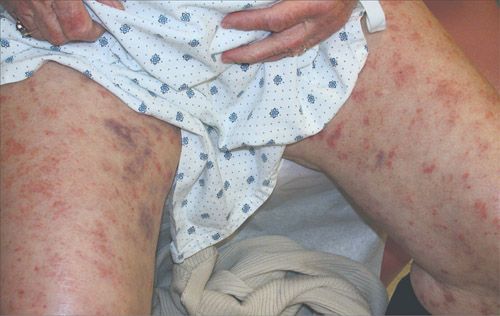
Figure 1 – A wider survey shows that the right thigh has more ecchymotic lesions, particularly medially, although the total density of the lesions is approximately symmetrical.

Figure 2 – Left thigh has papules that show very early coalescence toward plaques. Fine scale is present. Excoriations if any are inconspicuous here. There are no vesicles, and the surface of the skin is free of macroscopic breaches.
Judgment and experience, rather than any formula, help the examiner to decide which particulars, such as the small focus of dried serum (Figure 5), can be put aside: This is a subset of deciding which discordant data to eliminate, for it is more often than not the case that not all signposts in any domain of clinical practice point to the same diagnosis.
The intensity of a rash is often non-uniform; milder forms may be seen where scratching fingers can’t reach, or can only barely reach (Figures 3 and 6). Sometimes lesions in these areas prove less complex and more readily described, and thus deciphered. Precise observation and description are the premiere elements. With them one can confer with any consultant by telephone rather than just saying, “I have somebody with a wretched rash/mass/murmur.”
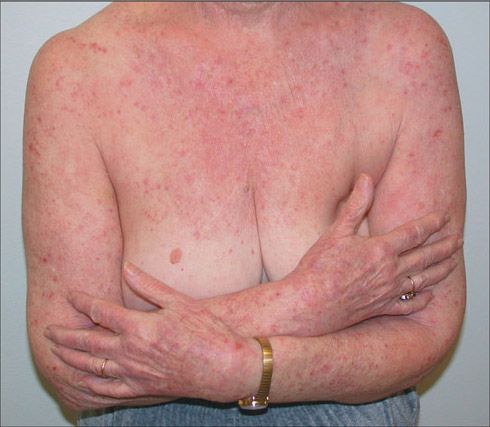
Figure 3 – Lesions are thickly spread across arms, hands, and anterior chest, though they look different than on legs: more scratching with unroofing, smaller size, more background erythema. Breasts proper appear to be spared and also look protected from sun-tanning; photodermatosis is unlikely because the pale, sun-free thighs are heavily involved.
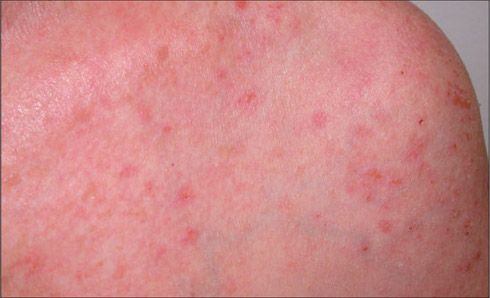
Figure 4 – Excoriation reaches a peak here at the left shoulder, where the majority of the lesions are barely raised, but almost all have been unroofed by the digging fingers.
Sometimes a “lesion” turns out to be the area that is normal, in just such unreachable zones.4 The most heavily excoriated areas often form a bewildering blur of unroofed skin where bits were torn off by the patient’s own fingernails (Figure 4), or where repetitive scratching rendered local vessels more permeable, leading to infiltration of fluid and inflammatory cells (Figure 7).
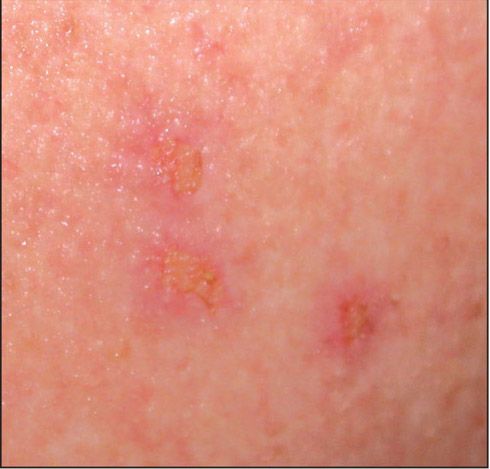
Figure 5 – Some of the unroofed lesions contain a sparse scab of dried yellow serum. One could wonder if this is a forme fruste of the “honey-like exudate” of impetigo; however, background erythema is much less than in such primarily streptococcal/ staphylococcal lesions.
MINIMAL LABORATORY HELP
One is likely to check, if only defensively, the INR, the aPTT, and the platelet count in view of the hemorrhagic lesions. Yet with lesions like these, rather than the more ominous and overpowering pattern of both broad swathes of bruising and panmucosal bleeding seen in disseminated intravascular coagulation and in purpura fulminans,5 the odds are very high that the laboratory testing will turn up nothing. On the other side, the relatively minor ecchymoses seen here are not simply a result of aspirin (so-called cardiologist’s purpura6) nor even of warfarin with INR in the therapeutic range.
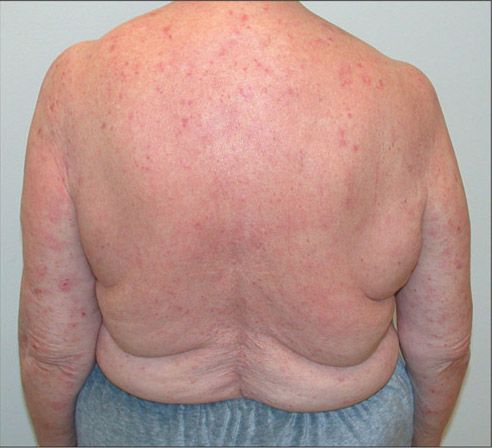
Figure 6 – Sparing of the mid- and lower back from excoriations contrasts with posterior arms and the trapezoid area. The back appears less stark because the underlying process is less exacerbated by behavior. Distribution of sparing faintly recalls the butterfly sign of chronic pruritus.
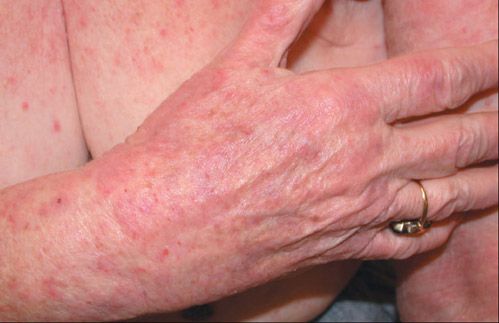
Figure 7 – At the hand and wrist, conveniently accessible to scratching, confluent erythema suggests infiltration, particularly over thenar border and radial aspect of wrist. This embodies both fluid insudation and some cellular inflammation that extends beyond the kind of punctate lesions best observed over the proximal dorsum of the hand on the ulnar aspect, and just proximal to the infiltrated area.
The much-touted search for eosinophilia in deciding the nature of a rash has been oversold. Many patients lack excess eosinophils even when their problem is clearly allergic; that this patient had eosinophilia does not change my opinion on the issue. A search for eosinophiluria to establish related allergic interstitial nephritis7 is likely to be unavailing. Monitoring the BUN and the creatinine at appropriate intervals keeps one’s attention on the more critical functional consequence of any renal involvement.
WHY IS IT NOT STEVENS-JOHNSON SYNDROME?
By definition, Stevens-Johnson syndrome includes mucosal involvement.8 Though we have not exhausted the list of places to look with conjunctiva and tongue-there remain gingival and buccal mucosa, palate, floor of mouth, pharynx, auditory canals, nares, vagina, and anus-this patient did not, in fact, have any affected mucosa.
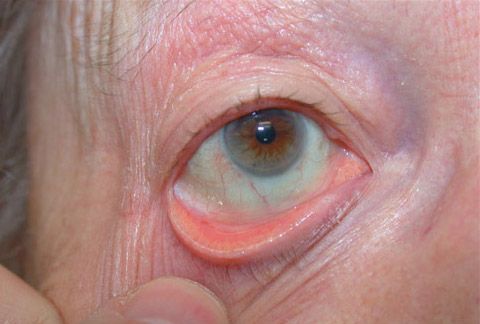
Figure 8 – In any puzzling skin disorder, other ectoderm may provide clues of great value. Here our patient’s conjunctiva is spared, and we are less likely to have a Stevens-Johnson syndrome. Incidental arcus cornealis lacks diagnostic or prognostic significance at this age. Periorbital skin demonstrates the atrophy (flattening and thinning) and augmented wrinkling that are very common in old age, all the more so in those with substantial lifetime solar injury, and most of all in smokers.
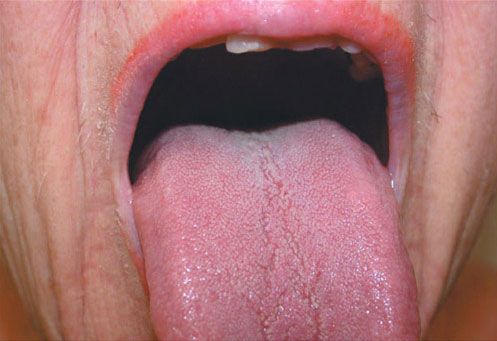
Figure 9 – The tongue offers another readily accessible mucous membrane; our patient’s is free of lesions and normally papillate. Sloppily applied lipstick above lateral portions of the narrow upper lip may reflect inattention due to feeling poorly, motor or visual deficits, dementia, or psychiatric issues.
We need to be wary, however, of interpreting the lack of mucosal involvement as implying an innocuous clinical course: while Stevens-Johnson syndrome is often thought of as the more severe and threatening variant of erythema multiforme,8,9 in fact the most lethal part of the spectrum is toxic epidermal necrolysis, which often spares the mucous membranes altogether.10
THERAPEUTIC INTERVENTION AND PROTRACTED COURSE
We promptly consulted a dermatologist. We also told the patient to regard herself as allergic to cephalosporins for the rest of her life. Despite the florid reaction, one might consider using a penicillin if needed sometime in the future: Some 15% of persons cross-react with both penicillins and cephalosporins. Whereas the standard teaching used to be that anybody allergic to one class must avoid the other, now that proscription is limited to those who have shown anaphylaxis or an equivalent, such as lip swelling or selective and pronounced facial flushing and edema.
For months, new lesions continued to appear. They finally regressed when, though still worried about creating mental dysfunction in the setting of her dementia and about worsening any other comorbid conditions, we prescribed a course of prednisone. This finally stopped the rash for good: She has not had a recurrence in the 5 years since.
LESSONS
The case is highly atypical in its persistence and progression after removal of the offending agent. One could speculate that hapten binding allowed perpetuation long after a parent substance had been excreted through the kidneys; but this would be merely scientific-sounding guesswork. Had the patient not had several visits with a seasoned and knowledgeable dermatologist, experienced in skin disorders of the aged, one might fear that another condition was responsible and remained undiagnosed. However, the consideration of alternative explanations for the findings was exhaustive and unproductive. A later separate diagnosis of psoriasis of the scalp emerged. But even in retrospect, the dermatologist was certain that psoriasis played no part in the striking findings illustrated here. Note that the nail photograph, included for completeness, can now be reviewed retrospectively for pits- not that these are a sensitive sign of psoriasis.
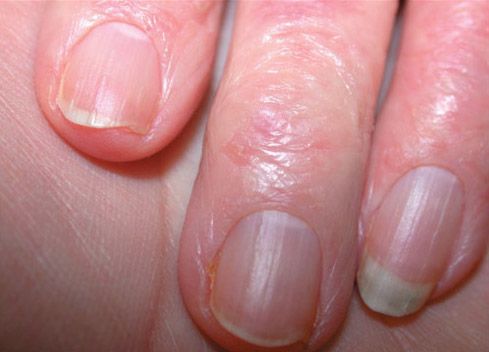
Figure 10 – Given the kinetics of their growth, fingernails would more characteristically become abnormal only after a longer period. However, we looked carefully at our patient’s and found nothing amiss. Cosmetic effect of poor cut on nail at viewer’s left and long nail at right, compared with the short cut in the middle, lacks medical importance.
We were thus reminded that in addition to the skin signs of systemic disease, which internists ponder far beyond their prevalence,11 the cutaneous problems of the aged12,13 can resemble those of the younger person. A last word: it would not be unprecedented for a patient with fixed ideas to continue taking a medicine from a personal stockpile, even after having earlier self-discontinued the same one; of course, if we were to invoke such a source for the persistence, we’d have to explain how she came to have hundreds of capsules.
Schneiderman H. Severe and persistent drug rash presumptively from cephalosporin. CONSULTANT. 2008;48:698-705.
References:
REFERENCES:1. Mosqueda L, Burnight K, Liao S. The life cycle of bruises in older adults. J Am Geriatr Soc. 2005;53:1339-1343.
2. Katta R, Anusuri V. Serum sickness-like reaction to cefuroxime: a case report and review of the literature. J Drugs Dermatol. 2007;6:747-748.
3. Williams LH, Raugi GJ, Dhaliwal G, et al. “Are we there yet?” J Hosp Med. 2007;2:181-188.
4. Akinlade BK, Schneiderman H, Gupta P. Butterfly sign of chronic pruritus. Consultant. 2002;42:903-912.
5. Auletta MJ, Headington JT. Purpura fulminans: a cutaneous manifestation of severe protein C deficiency. Arch Dermatol. 1988;124:1387-1391.
6. Karchmer AW, Ellman L. Petechiae due to drug-induced platelet dysfunction [letter]. N Engl J Med. 1976;295:451.
7. Ruffing KA, Hoppes P, Blend D, et al. Eosinophils in urine revisited. Clin Nephrol. 1994;41:163-166.
8. Patterson R, Dykewicz MS, Gonzalzles A, et al. Erythema multiforme and Stevens-Johnson syndrome: descriptive and therapeutic controversy. Chest. 1990;98:331-336.
9. Barnes SB, Dire DJ. Stevens-Johnson syndrome and the spectrum of erythema multiforme. Consultant. 1994;34:1721-1723.
10. Uwaifo GI, Schneiderman H, Daman LA. Toxic epidermal necrolysis (in this case related to terbinafine): a lethal dermatologic emergency. Consultant. 1999;39:1147-1167.
11. Cahill J, Sinclair R. Cutaneous manifestations of systemic disease. Aust Fam Physician. 2005;34:335-340.
12. Schneiderman H, Datunashvili A. Multiple age-associated dermopathies in a nonagenarian: senile comedones, solar elastosis, xanthelasmas, and perioral telangiectases. Consultant. 2003;43:1158-1164.
13. Martin JA, Finlay A. Skin disease in the elderly. Practitioner. 2006;250(1683): 6-8, 10, 12.